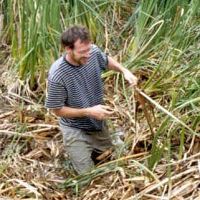Kelly et al., 2013
Interactions between cold and water limitation along a climate gradient produce sharp thresholds in ecosystem type, carbon balance, and water cycling
Kelly, A.E., M. Goulden, and A.W. Fellows (2013)
American Geophysical Union, Fall Meeting 2013, abstract #B23D-0585
-
Sierra, GRAD STUDENT
-
Sierra, INVESTIGATOR
-
Reynolds, Sierra, INVESTIGATOR, COLLABORATOR
Abstract
California's Mediterranean climate supports a broad diversity of ecosystem types, including Sequoia forests in the mid-montane Sierra Nevada. Understanding how winter cold and summer drought interact to produce the lush forest in the Sierra is critical to predicting the impacts of projected climate change on California's ecosystems, water supply, and carbon cycling. We investigated how smooth gradients of temperature and water availability produced sharp thresholds in biomass, productivity, growing season, water use, and ultimately ecosystem type and function. We used the climate gradient of the western slope of the Sierra Nevada as a study system. Four eddy covariance towers were situated in the major ecosystem types of the Sierra Nevada at approximately 800-m elevation intervals. Eddy flux data were combined with remote sensing and direct measurements of biomass, productivity, soil available water, and evapotranspiration to understand how weather and available water control ecosystem production and function. We found that production at the high elevation lodgepole site at 2700 m was strongly limited by winter cold. Production at the low elevation oak woodland site at 400 m was strongly limited by summer drought. The yellow pine site at 1200 m was only 4 °C cooler than the oak woodland site, yet had an order of magnitude more biomass and productivity with year-round growth. The mixed conifer site at 2000 m is 3.5 °C warmer than the lodgepole forest, yet also has higher biomass, ten times higher productivity, and year-round growth. We conclude that there is a broad climatological 'sweet spot' within the Sierra Nevada, in which the Mediterranean climate can support large-statured forest with high growth rates. The range of the mid-elevation forest was sharply bounded by water limitation at the lower edge and cold limitation at the upper edge despite small differences in precipitation and temperature across these boundaries. Our results suggest that small changes in precipitation or winter warming could markedly alter ecosystem structure and function as well as carbon and water cycling in the Sierra Nevada.
Citation
Kelly, A.E., M. Goulden, and A.W. Fellows (2013): Interactions between cold and water limitation along a climate gradient produce sharp thresholds in ecosystem type, carbon balance, and water cycling. American Geophysical Union, Fall Meeting 2013, abstract #B23D-0585.
 This Paper/Book acknowledges NSF CZO grant support.
This Paper/Book acknowledges NSF CZO grant support.
Explore Further


